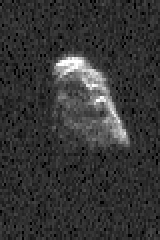Radar movie produced of 500-foot-wide asteroid

Cool image time! Astronomers have created a movie of radar images of a 500-foot-wide asteroid, dubbed 2024 MK, as it flew past the Earth on June 30, 2024 only 184,000 miles away, using two different radar dishes that are part of NASA’s Deep Space Network normally used for communications with planetary missions.
That movie is to the right.
The Deep Space Network’s 230-foot (70-meter) Goldstone Solar System Radar, called Deep Space Station 14 (or DSS-14), was used to transmit radio frequency signals to the asteroid, and the 114-foot (34-meter) DSS-13 received the reflected signals. The result of this “bistatic” radar observation is a detailed image of the asteroid’s surface, revealing concavities, ridges, and boulders about 30 feet (10 meters) wide.
This is not the first time an asteroid has been observed in this manner using radar, but it illustrates how the technique is becoming increasingly sophisticated, capable of producing images of surprising resolution.
On Christmas Eve 1968 three Americans became the first humans to visit another world. What they did to celebrate was unexpected and profound, and will be remembered throughout all human history. Genesis: the Story of Apollo 8, Robert Zimmerman's classic history of humanity's first journey to another world, tells that story, and it is now available as both an ebook and an audiobook, both with a foreword by Valerie Anders and a new introduction by Robert Zimmerman.
The print edition can be purchased at Amazon or from any other book seller. If you want an autographed copy the price is $60 for the hardback and $45 for the paperback, plus $8 shipping for each. Go here for purchasing details. The ebook is available everywhere for $5.99 (before discount) at amazon, or direct from my ebook publisher, ebookit. If you buy it from ebookit you don't support the big tech companies and the author gets a bigger cut much sooner.
The audiobook is also available at all these vendors, and is also free with a 30-day trial membership to Audible.
"Not simply about one mission, [Genesis] is also the history of America's quest for the moon... Zimmerman has done a masterful job of tying disparate events together into a solid account of one of America's greatest human triumphs."--San Antonio Express-News

Cool image time! Astronomers have created a movie of radar images of a 500-foot-wide asteroid, dubbed 2024 MK, as it flew past the Earth on June 30, 2024 only 184,000 miles away, using two different radar dishes that are part of NASA’s Deep Space Network normally used for communications with planetary missions.
That movie is to the right.
The Deep Space Network’s 230-foot (70-meter) Goldstone Solar System Radar, called Deep Space Station 14 (or DSS-14), was used to transmit radio frequency signals to the asteroid, and the 114-foot (34-meter) DSS-13 received the reflected signals. The result of this “bistatic” radar observation is a detailed image of the asteroid’s surface, revealing concavities, ridges, and boulders about 30 feet (10 meters) wide.
This is not the first time an asteroid has been observed in this manner using radar, but it illustrates how the technique is becoming increasingly sophisticated, capable of producing images of surprising resolution.
On Christmas Eve 1968 three Americans became the first humans to visit another world. What they did to celebrate was unexpected and profound, and will be remembered throughout all human history. Genesis: the Story of Apollo 8, Robert Zimmerman's classic history of humanity's first journey to another world, tells that story, and it is now available as both an ebook and an audiobook, both with a foreword by Valerie Anders and a new introduction by Robert Zimmerman.
The print edition can be purchased at Amazon or from any other book seller. If you want an autographed copy the price is $60 for the hardback and $45 for the paperback, plus $8 shipping for each. Go here for purchasing details. The ebook is available everywhere for $5.99 (before discount) at amazon, or direct from my ebook publisher, ebookit. If you buy it from ebookit you don't support the big tech companies and the author gets a bigger cut much sooner.
The audiobook is also available at all these vendors, and is also free with a 30-day trial membership to Audible.
"Not simply about one mission, [Genesis] is also the history of America's quest for the moon... Zimmerman has done a masterful job of tying disparate events together into a solid account of one of America's greatest human triumphs."--San Antonio Express-News


Whenever I’m watching radar of rocks, it always looks like there’s a sunlit side. But there isn’t because the radar is doing the illumination of the front surface.
It must be solid. It seems to me that it’s spinning too fast for a “gravel” asteroid of that size to hold itself together.
Either that or the video is on fast-forward.
Mark Sizer wrote: “Either that or the video is on fast-forward.”
The article said that the images were made at one-minute intervals. I count 244 images, which would be a four-hour period. The video of them plays in about half a minute, which suggests to me that it is sped up by a factor of 500-ish.